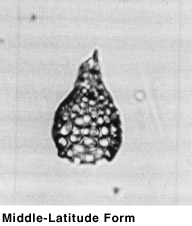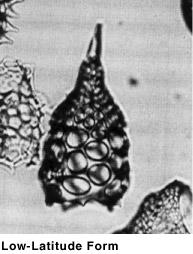 Lamprocyrtis
neoheteroporos Kling
Lamprocyrtis
neoheteroporos Kling Lamprocyrtis
neoheteroporos Kling
Lamprocyrtis
neoheteroporos KlingLamprocyrtis neoheteroporos Kling, 1973, p.639, pl.5, figs.17-18, pl.15, figs.4-5
Two segmented forms with cephalis [three-lobed,] hemispherical to cylindrical, commonly open; with a stout three-bladed apical horn and usually one or more accessory spines; with circular to elliptical, irregularly arranged pores. Collar stricture indistinct. Thorax proximally conical, distally cylindrical to slightly inflated; circular to elliptical or irregular pores, longitudinally aligned, increasing in size distally, becoming two or more times as large along a horizontal discontinuity as in L. heteroporos. Smaller pores may again appear near mouth. Although early specimens show a slight, gentle indentation of the wall at this discontinuity, there is no internal stricture or septal ring separating two segments. Mouth, sometimes slightly constricted, surrounded by irregular row of small teeth; a weak peristome seldom developed. Later specimens become smaller and more inflated (Kling, 1973).
 DIMENSIONS
DIMENSIONSBased on 15 specimens. Maximum width 74-90 µm, length from top of cephalis 100-130 µm, proximal pore diameter 2-14 µm, (average near upper value), distal pore diameter 6-28 µm (average near upper value) (Kling, 1973).
The pores in the proximal part of the postcephalic shell are small, and distally they are two to three times as large, the change occurring abruptly as at an intersegmental boundary, which, however, is not marked by an internal stricture (Riedel and Sanfilippo, 1978a).
This species is distinguished from L. heteroporos by the absence of a lumbar constriction with an internal septal ring. It differs from L. nigriniae in having a transverse discontinuity across which the pore size differs by a factor of two or more (Sanfilippo et al., 1985).
The shell is two-segmented, but shows evidence of its three-segmented ancestor by an abrupt increase in pore size (by a factor of two or more) between the upper and lower parts of the present thorax. The species varies from a compact, small (100 µm in length) form with heavy bars between pores, to a larger form (140 µm in length) with more open lattice and lighter bars (Sanfilippo et al., 1985).
L. neoheteroporos occurs in late Pliocene early Quaternary assemblages in latitudes lower than 40°, but is rare in tropical sediments. Its morphotypic first appearance lies within the Pterocanium prismatium Zone and its morphotypic last appearance lies within the Anthocyrtidium angulare Zone in low-latitude sediments. In middle latitudes its morphotypic first appearance lies within the Eucyrtidium matuyamai Zone and its morphotypic last appearance lies within the Stylatractus universus Zone.
L. neoheteroporos arose from L. heteroporos, and evolved into L. nigriniae. See also discussion under Phylogeny of L. heteroporos.
Additional illustrations can be found in Goll, 1980, pl.3, fig.11.